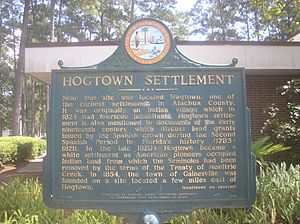Hogtown, Florida facts for kids
Hogtown was a small community that existed in the 1800s, located near what is now Westside Park in Gainesville, Florida. It was named after the nearby Hogtown Creek. Originally, Hogtown was a village where Seminole people lived and raised hogs. People from nearby areas called it "Hogtown" because they traded with the Seminoles there.
In 1824, only 14 people lived in Hogtown. After the United States took control of Florida, more settlers from Europe began to move into the area. A special agreement called the Treaty of Moultrie Creek was made in 1823. This treaty required the Seminoles to move to a reservation in central Florida. As part of this agreement, a Seminole leader named Chief John Mico received $20 for the improvements his people had made in Hogtown.
Contents
Seminole Treaties and Tensions
The Treaty of Payne's Landing
In 1832, another agreement called the Treaty of Payne's Landing was signed. This treaty said that the Seminoles in Florida had to move west of the Mississippi River within three years. However, most Seminoles did not want to leave their homes in Florida. As the time to move got closer, tensions grew between the Seminoles and the new settlers.
The Hogtown Incident
In June 1835, an event known as the "Hogtown Incident" took place. A group of seven or eight Seminoles were hunting outside the reservation and had killed a cow. They made a camp near Hogtown. A group of white settlers found some of the Seminoles at their camp. The settlers took the Seminoles' weapons and began whipping them. When the other two Seminoles returned to camp and saw what was happening, they started shooting at the settlers. During the fight, three settlers were hurt, and one Seminole was killed. Another Seminole was also badly wounded.
The government agent, Wiley Thompson, demanded that the surviving Seminoles be handed over. They were taken into custody for a trial. However, there is no record that a trial ever happened. This was reportedly because the settlers involved did not want their actions to be looked at in court. Later, in August, a soldier named Private Kinsley Dalton was killed while delivering mail. Some believed this was in revenge for the Seminoles who were killed at Hogtown.
The Second Seminole War Begins
The Second Seminole War started in late December 1835. A major event that began the war was the Dade Massacre, where 107 United States Army soldiers were killed by Seminoles. After this, settlers all over Florida either left their homes or built defenses to protect themselves. The people living in Hogtown built a fort called Fort Hogtown. They also joined a local defense group known as the Spring Grove Guards.
From Hogtown to Gainesville
Choosing a New County Seat
In 1853, people in Alachua County realized that a new railroad, the Florida Railroad, would not pass through their county seat, Newnansville. A meeting was held at Boulware Springs to discuss moving the county seat to a new town that would be on the railroad's path.
William Lewis, who owned a large farm in Hogtown, offered to gather 20 votes to support a new town on the railroad route. He suggested that if this new town did not become the county seat, it should be named Lewisville. Lewis didn't think there would be enough votes to move the county seat.
However, another farm owner from Hogtown, Tillman Ingram, also owned a sawmill there. Ingram offered to build a courthouse in the new town for a very good price. His offer was so appealing that the move was approved. The new town was then named "Gainesville."
Building Gainesville
Tillman Ingram built Oak Hall, which was said to be the first important house in downtown Gainesville. He also built the first courthouse. Wood from Ingram's sawmill in Hogtown was also used to build the oldest house in Gainesville, the Bailey House. This house was built on the Bailey Plantation even before Gainesville was officially established.
Hogtown Today
An old map from 1855 shows both Hogtown and Gainesville. You can find this map on the website of the Alachua County Library District.
In 1961, the City of Gainesville officially took over the land where Hogtown used to be. Even today, many people still use "Hogtown" as another name for Gainesville. Many businesses and events in Gainesville use the name "Hogtown" to show their connection to the area's history.
Images for kids



